

WORKER MISCLASSIFICATION: WHY AND HOW NOT TO GO THE UBER AND NIKE WAY Exclusive interview with Matthew Iverson, Partner, Nelson Mullins JUNE 2023 • Vol.10 • No.06 (ISSN 2564-2022) 19 14 24 30 Workplace Unions Will Become More Prevalent In 2023 - Exclusive interview with Tom Mandler, Co-Chair, Traditional Labor Law, Akerman LLP The Legal Implications Of Using ChatGPT And Generative AI In The Workplace - Shaniqua L. Singleton, Nelson Mullins Pay Equity: Systematic Pay And Promotion Discrimination Against Women Damages Workplaces - Jaclyn Margolis, Pepperdine Graziadio Business School Navigating Reasonable Accommodation And Confidentiality For Employees With ADHD - Exclusive interview with John Veysey, Of Counsel, Nelson Mullins
On the Cover
Articles
12 Worker Classification, Or Misclassification, In The Gig Era
- Exclusive interview with Olivia Cicchini, Legal Specialist, Peninsula Canada
16 NLRB General Counsel Reverses Host Of Prior Administration Precedent: A Warning Sign For Employers
Navigating evolving board doctrines

- Mitchell Boyarsky, Partner, Nelson Mullins Riley & Scarborough LLP
21 Ban On Post-Employment Non-Competes: Minnesota To Join The League Minnesota will become the fourth state to impose a complete ban on post-employment noncompetes
- Daniel G. Prokott, Charles F. Knapp, Rhiannon C. Beckendorf, Erik Mosvick and Zoey A.Y. Twyford, Faegre Drinker
Worker Misclassification: Why And How Not To Go The Uber And Nike Way
- Exclusive interview with Matthew Iverson, Partner, Nelson Mullins
26 How To Protect SMB Employees And Customers’ Data

Safeguarding company data from the common threats organizations face
- Tony Anscombe, Chief Security Evangelist, ESET
34 President Biden’s National Labor Campaign: Expanding Protected Activity New protections for workers' conduct
- Allison Hawkins, Associate, Labor and Employment Practice, Burr & Forman
INDEX HR Legal & Compliance Excellence JUNE 2023 Vol.10 No.06 (ISSN 2564-2022)
08
Straight Talk with HR.com
Straight Talk with HR.com Workplace Unions Will Become More Prevalent In 2023

- Exclusive interview with Tom Mandler, Co-Chair, Traditional Labor Law, Akerman LLP
TOP PICKS 14 19
The Legal Implications Of Using ChatGPT And Generative AI In The Workplace

Best practices for implementing AI

- Shaniqua L. Singleton, Senior Associate, Nelson Mullins
24
Pay Equity: Systematic Pay And Promotion Discrimination Against Women Damages Workplaces

Lessons from Goldman Sachs' $215 million discrimination settlement
- Jaclyn Margolis, Associate Professor, Applied Behavioral Science, Pepperdine Graziadio Business School
30
Straight Talk with HR.com Navigating Reasonable Accommodation And Confidentiality For Employees With ADHD
- Exclusive interview with John Veysey, Of Counsel, Nelson Mullins
INDEX
How are our Legal & Compliance Products and Services helping to make you smarter?
Legal & Compliance Excellence - Monthly Interactive Learning Journal
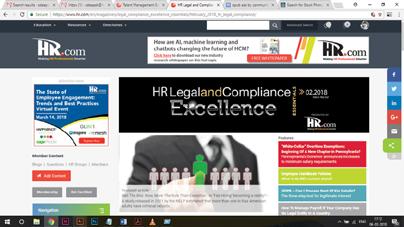
This monthly interactive learning experience showcases solutions to deal with the latest legal and compliance issues facing corporations and legal departments.
Legal and Compliance Webcasts for Credit
HR.com offers various informative webcasts on a variety of topics including the latest HR compliance updates and legal considerations for employers and all HR professionals. Webcasts are available live online with a downloadable podcast and a copy of the slides (PDF) available before and after each webcast. Earn all of the required recertification credits for aPHR, PHR, SPHR, GPHR, and SHRM Certifications. HR.com’s one-hour webcasts, in every HR specialty including Legal and Compliance, are pre-approved for HRCI and SHRM credit (excluding Demo webcasts).
Legal and Compliance Community
Join almost more than 30,000 HR.com members with a similar interest and focus on compliance on legal regulations in HR. Share content and download research reports, blogs, and articles, network, and “follow” peers and have them “follow” you in a social network platform to communicate regularly and stay on top of the latest updates. This well established Legal and Compliance Community is an invaluable resource for any HR professional or manager.

SEP 2017 Vol. No. 09 Use these invaluable Legal & Compliance resources today! For more information phone: 1.877.472.6648 | email: sales@hr.com | www.hr.com
Editorial Purpose
Our mission is to promote personal and professional development based on constructive values, sound ethics, and timeless principles.
Excellence Publications
Debbie McGrath CEO, HR.com - Publisher
Sue Kelley Director (Product, Marketing, and Research)
Babitha Balakrishnan and Deepa Damodaran Excellence Publications Managers and Editors
HR Legal & Compliance Excellence Team
Deepa Damodaran Editor

Koushik Bharadhwaj Junior Editor
Chinnavel Design and Layout (Digital Magazine)
Vibha Bangalore Magazine (Online Version)
Submissions & Correspondence
Please send any correspondence, articles, letters to the editor, and requests to reprint, republish, or excerpt articles to ePubEditors@hr.com
For customer service, or information on products and services, call 1-877-472-6648
Opportunities, email:
HR Legal & Compliance Excellence (ISSN
Debbie Mcgrath Publisher, HR.com
Deepa Damodaran Editor, HR Legal & Compliance Excellence
HR’s Role in Addressing Workplace Unions, Pay Equity and Worker Misclassification

Organizations are facing a myriad of challenges, ranging from pay equity to worker misclassification to labor unions and to reasonable accommodations. These issues have significant implications for both employees and employers, impacting not only financial stability but also workplace dynamics and employee satisfaction.
Labor unions play a crucial role in advocating for workers' rights, collective bargaining, and fostering better working conditions. As the dynamics of the modern workplace continue to evolve, we explore the relevance of labor unions in today's context. Read, Workplace Unions Will Become More Prevalent In 2023, where Tom Mandler from Akerman LLP touches upon the potential benefits and challenges associated with unionization, the role of unions in protecting workers' interests, and how organizations can effectively navigate relationships with labor unions.
The misclassification of workers as independent contractors rather than employees is another area of concern for employers. While this practice can lead to various consequences, including potential legal ramifications, financial penalties, and disputes over benefits and worker protections, what is alarming is despite laws and regulations this is still rampant.
Recent cases involving Uber and Nike highlight the repercussions of misclassification. Check out Matthew Iverson (from Nelson Mullins) and Olivia Cicchini's (Peninsula Canada) interviews, as they examine the reasons behind worker misclassification, the impact on both employers and employees and steps
organizations can take to avoid misclassification pitfalls.
Pay equity has emerged as a critical focus in recent years. Organizations strive to ensure fair compensation for all employees, regardless of gender, race, or other protected characteristics. However, the recent Goldman Sachs case, where the Silicon Valley bank was ordered to pay a $215 million discrimination settlement to former and current female employees is a wake-up call to companies to take a deep, hard look into their existing processes to see if they are unintentionally, or intentionally, favoring men over women workers.
Check out Pay Equity: Systematic Pay And Promotion Discrimination Against Women Damages Workplaces, where Jaclyn Margolis from Pepperdine Graziadio Business School delves into the importance of pay equity and explores strategies for organizations to foster a more equitable compensation structure.
That's not all! This edition of HR Legal & Compliance Excellence also covers other legal aspects and highlights that are essential for maintaining a healthy, safe, and secure workforce. We hope that the insights and information presented in this edition will help you create a more equitable workplace and foster a culture that values diversity and inclusion.
Happy Reading!
Disclaimer: The views, information, or opinions expressed in the Excellence ePublications are solely those of the authors and do not necessarily represent those of HR.com and its employees. Under no circumstances shall HR.com or its partners or affiliates be responsible or liable for any indirect or incidental damages arising out of these opinions and content. EDITOR’S NOTE
Subscribe now for $99 / year And get this magazine delivered to your inbox every month Become a Member Today to get it FREE! SIGN UP OR
form
credited.
For Advertising
sales@hr.com Copyright © 2023 HR.com. No part of this publication may be reproduced or transmitted in any
without written permission from the publisher. Quotations must be
published monthly by HR.com Limited, 56 Malone Road, Jacksons Point, Ontario L0E 1L0
Address: www.hr.com Write to the Editor at ePubEditors@hr.com
2564-2022) is
Internet
In a world of unparalleled challenges (global pandemic, racial injustice, political rivalry, digital 4.0, emotional malaise), uncertainty reigns. Finding opportunity in this context requires harnessing uncertainty and harnessing starts with reliable, valid, timely, and useful information. The Excellence publications are a superb source of such information. The authors provide insights with impact that will guide thought and action.

Excellence publications are my ‘go-to’ resource for contemporary and actionable information to improve leadership, engagement, results, and retention. Each edition offers rich and diverse perspectives for improving the employee experience and the workplace in general.



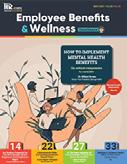





I regularly read and contribute to Leadership Excellence and Talent Management Excellence. I use many of the articles I read to augment my own presentations and I often share the articles with my clients. They are always quick, right on target for the latest issues in my field, and appreciated by my clients. If you want to stay up to date on the latest HR trends, choose a few of the different issues from the Excellence series of publications.



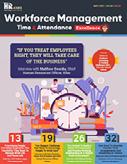

 Dave Ulrich
Rensis Likert Professor, Ross School of Business, University of Michigan Partner, The RBL Group
Julie Winkle Giulioni Author, Virtual /Live Keynote Presenter, Inc.’s Top 100 Leadership Speakers
Dr. Beverly Kaye CEO, BevKaye&Co.
Dave Ulrich
Rensis Likert Professor, Ross School of Business, University of Michigan Partner, The RBL Group
Julie Winkle Giulioni Author, Virtual /Live Keynote Presenter, Inc.’s Top 100 Leadership Speakers
Dr. Beverly Kaye CEO, BevKaye&Co.
WHY EXCELLENCE PUBLICATIONS?
We’re eager to hear your feedback on our magazines. Let us know your thoughts at ePubEditors@hr.com

ePublication EditorialCalendar Checkoutthenewandupcoming themedHRtopicsinHRLegal& ComplianceExcellence Check ePublications Editorial Calendar Here. Would you like to submit an article? | Write to us at ePubEditors@hr.com Submission Guidelines 1 Contingent Work Jan 2023 2 Cybersecurity Feb 2023 3 Worker Immigration Mar 2023 4 Substance Abuse and Marijuana in the Workforce Apr 2023 5 Workplace Equity - Interview Special May 2023 6 Workplace Unions and HR Jun 2023
The misclassification of workers has become a concerning issue for companies, potentially leading to hefty fines and class-action lawsuits. Recent cases involving Uber and Nike highlight the repercussions of misclassification.
In an exclusive interview with HR.com, Matthew Iverson, a Partner at Nelson Mullins, sheds light on the reasons behind worker misclassification and the challenges employers face in properly classifying workers amidst stricter rules and regulations. He also shares key insights on this persistent problem and will help us gain a deeper understanding of how it can be prevented in the future.

Worker Misclassification: Why And How Not To Go The Uber And Nike Way
Excerpts from the interview:
Q:Uberpaid $8.4 million to settle a class-action lawsuit for misclassifying workers in 2022. Nike is currently facing a potential $530 million fine for misclassifying workers. Why do companies continue to misclassify workers despite stringent laws and hefty penalties?
Matthew: Many employee advocates and government enforcement agencies will say that companies misclassify workers because engaging an independent contractor is cheaper than hiring an employee. This does happen, but the answer is often more complicated than that.
Engaging an independent contractor is, in some cases, cheaper than hiring an employee. After all, employees receive many benefits, like overtime, health care and worker’s compensation, that independent contractors do not – and as a result, some companies use independent contractors in place of traditional employees because they believe doing so saves money.
But this approach only saves money so long as the company does not get caught. The penalties for violating misclassification
HR Legal & Compliance Excellence presented by HR.com June 2023 8 Submit Your Articles
Straight Talk with HR.com
COVER ARTICLE
Exclusive interview with Matthew Iverson, Partner, Nelson Mullins
laws typically dwarf any prior savings. This is by design, as misclassification laws are drafted to make sure that the costs of misclassification outweigh its benefits.
Many companies, however, misclassify workers by mistake. Independent contractor laws vary widely by state. For example in Texas, an independent contractor is not an employee so long he or she is free from control or direction under a contract. In Massachusetts and California, however, an independent contractor is an employee, regardless of the level of control, if he or she merely works in the same course of business as the company that offered the contract.
This means, for example, that an accounting firm may not legally engage an accountant as an independent contractor in Massachusetts or California, regardless of the level of control the firm exerts over them.

These differing standards create traps for unwary companies. There are also federal standards for classifying independent contractors that apply throughout the country, and those standards change frequently with the administration in power.
Finally, some companies, including many in the gig economy, structure their businesses so that contractors are an inherent part of their model. Ridesharing companies are an example of this phenomenon. The ridesharing business model, reduced to its essence, connects people looking for rides with other people willing to drive them in exchange for a fee. At least initially, ridesharing companies lacked the infrastructure and resources to formally employ hundreds of thousands, if not millions, of drivers across the country and the world. Most ridesharing companies viewed independent contracting as the only economically realistic option for the industry, and they accepted the risk of misclassification liability as the price the doing business.
Over the past decade or so, courts, regulatory agencies, and legislatures have focused on industries that make regular use of contractors, including those in the gig economy, and many companies were forced to fight pitched legal battles to defend their business models. Sometimes those battles were lost, and many gig-economy companies faced steep penalties as a result.
HR Legal & Compliance Excellence presented by HR.com June 2023 9 Submit Your Articles
Straight Talk with HR.com
Q:Were these cases preventable? How?
Matthew: Some misclassification cases are preventable. If a company is using an independent contractor in a role that would normally be filled by an employee simply because the independent contractor is cheaper, this presents an obvious and avoidable liability risk. Informed human resources (HR) leadership can usually eliminate these risks by examining their companies’ independent contractors and putting those doing the work of employees on the payroll.
Other misclassification cases are more difficult to prevent because the misclassification risks are less obvious or less certain. The legal standards used to determine misclassification are subjective, and, especially in borderline cases, different judges may look at the same contractual relationship and reach different conclusions about whether it constitutes employment.
Companies that contract in multiple states also risk mistakenly misclassifying a contractor because they misunderstand the legal landscape outside their home jurisdiction. If a company is at all uncertain as
to whether its contractors are properly classified, it should consult a lawyer familiar with the independent contractor laws in all the states where they contract because there are ways to minimize misclassification risk through proper preparation.

Q:What are the takeaways for employers from such cases?
Matthew: There are three important takeaways for companies that use independent contractors.
First, companies that choose to use independent contractors to save money by reducing employee headcount should take a long, hard look at that policy. Their contractor relationships may well be illegal, and if caught, those companies may face legal penalties that drown the hoped-for cost savings.
Second, companies should not assume that because their contractor relationships pass muster in their home state, they also comply with the laws of other states. Likewise, companies should not assume relationships that were legal five years ago are still legal today. Companies that contract in new states or have not reviewed their contract relationships recently should consider having their contracts reviewed by a legal professional.
HR Legal & Compliance Excellence presented by HR.com June 2023 10 Submit Your Articles
Straight Talk with HR.com
Finally, companies whose business models require contracting, like many gig economy companies, should fully understand the potential liability risks inherent in the way they operate. In many cases, misclassification exposure can be minimized, or at least reduced, by tweaking the contractual relationships to better comport with applicable law or by incorporating contractual safeguards against mass liability, like arbitration clauses. If your business model depends on independent contractors, informed legal advice is essential.
The first problem is that there is no consensus within most governments regarding what types of independent contractor relationships should be prohibited. Lawmakers have opinions that fall across the regulatory spectrum. Some want no restrictions at all, others want to eliminate independent contractors and most fall somewhere in the middle.
The second problem lawmakers face is that because independent contracting takes so many forms, and companies can be creative in their attempts to avoid formal employment, it is difficult to craft statutory language that prevents the misclassification of independent contractors.
Matthew: Federal and state misclassification laws are ambiguous because they are not objective. The test for misclassification under the federal Fair Labor Standards Act, for example, relies on a multi-factored “economic realities test” that considers a variety of circumstances, including the amount of control exercised by the company that issued the contract, the permanence of the relationship, the skill required by the individual and the opportunity that the worker has for profit or loss.
All these factors are subjective, and there is no real consensus amongst courts over how they should be weighed or even how many factors should be considered in a particular instance. As a result, judges often apply an “I know it when I see it” attitude to misclassification. As different judges may see the same facts differently, this makes it hard to predict the legality of a particular contract in advance.
Although state misclassification tests often rely on a smaller number of factors, and some state tests weigh the outcome more in favor of or against a finding of employment, all tests have subjective components that make a misclassification outcome hard to predict.
Both problems combine to produce statutes with vague language born of political compromise. This vague language provides plaintiffs’ lawyers with openings to bring misclassification claims against entities that most lawmakers likely never considered to be operating illegally.
For example, some plaintiffs’ lawyers have recently argued that franchising should be reclassified as employment under some states’ independent contractor laws. Vague statutory language also leaves courts with the unenviable task of figuring out which relationships lawmakers intended to prohibit.
If lawmakers want to deal with misclassification effectively, they should first reach a consensus as to which types of work relationships they wish to criminalize and which they do not, and then craft statutes that delineate between the two.
Matthew: Lawmakers attempting to address misclassification face two problems.
HR Legal & Compliance Excellence presented by HR.com June 2023 11 Submit Your Articles
you like to comment?
Would
Q:Please explain the ambiguity that exists in the federal and state laws on classifying workers.
Q:What changes must lawmakers bring in to deal with worker misclassification more stringently?
Straight Talk with HR.com
Worker Classification, Or Misclassification, In The Gig Era
When companies fail to classify workers properly, they are potentially inviting huge fines from tax authorities and the possibility of class-action lawsuits. In September 2022, Uber coughed up $8.4 million to settle a class-action lawsuit with California drivers, who claimed they were misclassified as independent contractors, rather than employees. This is not the first time that Uber has been embroiled in a misclassification case. Similarly, Nike is now facing potential tax fines of more than $530 million for misclassifying thousands of its temporary office workers. Uber and Nike’s cases are not isolated ones. Microsoft, Time Warner Inc., FedEx, etc., have been caught in this mess in the past.
Employers continue to be misclassified as independent contractors. Why does this happen? Can worker misclassification be prevented? In an exclusive interview with HR.com, Olivia Cicchini, Legal Specialist, Peninsula Canada, shares her insights into why companies continue to misclassify workers in the age of stringent rules and regulations and what are the challenges employers will face while classifying workers in the future, among others.

Excerpts from the interview:
Q:Uber’s $8.4 million fine in 2022 and Nike’s potential $530m fine for misclassifying workers in 2023, among others - why do companies continue to misclassify workers?
Olivia: While no one can know for sure, it can generally be assumed that companies misclassify workers because they are either unsure of their legal obligations or are purposefully engaging in this behavior for cost-saving benefits. When an employee is incorrectly classified as an independent contractor, companies avoid paying certain taxes and benefits and have less of a legal responsibility toward their staff.
Q:Were these cases preventable?
How?
Olivia: These cases can be prevented by consulting with a qualified legal professional during the hiring process. By asking specific questions to get to the root of the employment
HR Legal & Compliance Excellence presented by HR.com June 2023 12 Submit Your Articles
Straight Talk with HR.com
Exclusive interview with Olivia Cicchini, Legal Specialist, Peninsula Canada
relationship, employers can better understand whether the worker will be considered an employee or not.
Q:What are the takeaways for employers from such cases?
Olivia: Employers should look at these cases as cautionary tales of what not to do when classifying workers. While companies may experience shortterm cost-saving benefits from misclassifying staff, they may be opening themselves up to liability. If the company does encounter a misclassification claim from a worker (or workers), it can mean public scrutiny, retroactive payments, punitive damages, and more. Classifying workers correctly from the start is always the best practice.
Q:What are the common mistakes employers commit while classifying workers?
Olivia: A common mistake employers encounter while classifying workers is that the workers' classification depends on the nature of the employment relationship, not their title. For example, some companies will call an employee an independent contract believing that this will be
enough. However, despite what a worker is classified as in their employment contract, it is the worker’s risk of profit and loss, ability to subcontract work, protection from disciplinary action, and other qualifying factors that determine their status as an employee or independent contractor.
Q:With the proliferation of the gig economy, what are the challenges employers will face while classifying workers in the future?

Olivia: Starting with Ontario in 2022, governments in Canada are beginning to implement amendments to their employment standards legislation to provide protections for gig economy workers which in turn will help sort out the classification issues. Gig economy workers were typically classified as independent contractors. Once the new legislation takes effect, the workers will be afforded certain minimum standards and protections under employment standards legislation, forcing employers to reconsider that classification.
Q:What changes must lawmakers bring in to deal with worker misclassification more stringently?
Olivia: Taking gig economy workers as an example, the aforementioned legislation push is in progress but risks introducing confusion into the classification process before offering up clear categories. Generally, this may be more about ensuring employers understand the nature of the employment relationship and that they should not always be looking for costsaving benefits when misclassification itself can end up being a costly mistake.
Would you like to comment?
HR Legal & Compliance Excellence presented by HR.com June 2023 13 Submit Your Articles Straight Talk with HR.com
Workplace union activities are on the rise. According to a recent report by the National Labor Relations Board (NLRB), illicit labor charges have risen by 16%, while union filings increased by 2% upward, over the past fiscal year. In 2022, the agency saw a record level of new cases, which had risen by 23% during that period. As complaints continue to come in, the NLRB noted that the 2023 fiscal year could have the second-highest record for case filings.
In an exclusive interview with HR.com, Tom Mandler, Co-Chair, Traditional Labor Law, Akerman LLP, shares his insights into the factors contributing to this increase, what employers must do to navigate the legal concerns associated with the increase in labor complaints and union filings, among others.

Workplace Unions Will Become More Prevalent In 2023
Excerpts from the interview:
Q:Can you provide us an overview of the NLRB report and the trends that it highlights.
Tom: Workplace unions are becoming more aggressive:
1. Gallop poll indicates public support of unions is 74% as compared to 48% in 2010.
2. Gen Z employees support unions as a means of furthering their goals, such as social conscience, pay equity and racial justice.
3. Daily news reports of union activities (such as Amazon, Apple, and Starbucks) that are creating pro-union publicity and interest.
4. NLRB's rapid issuance of new decisions and General Counsel’s statements changing decades of precedent favoring union activity and organizing.
HR Legal & Compliance Excellence presented by HR.com June 2023 14 Submit Your Articles
Straight Talk with HR.com
TOP PICK
Exclusive interview with Tom Mandler, Co-Chair, Traditional Labor Law, Akerman LLP
Q:What are the factors contributing to the increase in labor complaints and union filings?
Tom: The three main factors contributing to this trends are:
1. Joe Biden is the most pro-union president the U.S. ever had.
2. NLRB is changing decades-old precedents in favor of unions.
3. High-profile union organizing is reported in the news.
Q:What are the potential liabilities businesses may face as a result of this trend, particularly in light of the ongoing backlog of labor complaints with the NLRB?
Tom: Employers must ensure that their supervisors understand how to manage employees without incurring ULP charges and what can be done legally to prevent union organizing.
Q:How can businesses navigate the legal concerns associated with the increase in labor complaints and union filings?
Tom: Supervisory training. The most effective unionfree programs focus on creating a positive employee culture. The most significant component of that is training supervisors so they treat employees with dignity and respect and make employees feel that they are important contributors to the employer’s success.

Q:How can businesses ensure that they are in compliance with labor, equal employment opportunity, wage and hour, affirmative action, and occupational safety and health laws?
Tom: Employers should have outside labor counsel conduct audits of their employment practices, including providing the above mentioned supervisory training.
Q:How can businesses effectively communicate with their employees to prevent labor disputes and promote positive relationships between management and labor?
Tom: Properly trained supervisors should be the prime communicators because they interact with employees on a daily basis.
Q:How can businesses balance the need to maintain productivity and profitability with their legal obligations to employees and their labor rights?
Tom: Although a union-free program may initially involve some increase in costs, in the long run, the employees should be more satisfied with their jobs and perform them better.
Q:What are the trends and challenges expected in the labor and employment landscape, and how can businesses prepare for these changes?
Tom: Union activity will continue to increase, so employers must take the above actions at a minimum. The NLRB will continue to issue more pro-union decisions. Unions will continue to make news this summer: teamsters' negotiations with ups, united autoworkers negotiating with the big three auto companies, etc. These and other developments will make maintaining union-free status more challenging.
HR Legal & Compliance Excellence presented by HR.com June 2023 15 Submit Your Articles
Straight Talk with HR.com
Would you like to comment?
NLRB General Counsel Reverses Host Of Prior Administration Precedent: A Warning Sign For Employers
Navigating evolving board doctrines
By Mitchell Boyarsky, Nelson Mullins Riley & Scarborough
Common workplace legal principles – including those typically significant for non-union employers – are facing a substantial challenge underpinned by memoranda from the highest lawyer of the National Labor Relations Board (NLRB or the board), which administers federal labor law.
Not long ago, on Aug. 12, 2021, soon after Jennifer Abruzzo began serving as general counsel for NLRB, she issued her first General Counsel Memorandum (21-04), confirming the intuition of many observers about her and her position on recent board law — she intended to undo what she perceived as the “wide array of doctrinal shifts,” which “overrul[ed] many legal precedents that struck an appropriate balance between the rights of workers and the obligations of unions and employers”.
Board law can change based on NLRB decisions or advice memoranda from the Office of the General Counsel providing guidance to the regional offices of the NLRB to interpret and administer the National Labor Relations Act (NLRA or the act). During Abruz-
zo’s term, a barrage of limits on management prerogatives has been underway through board decisions and advice memoranda issued by her office.
The August 2021 memorandum highlighted subject matter areas where, according to general counsel Abruzzo, the prior Trump board had overruled past legal precedent. Abruzzo’s focus spanned a wide range, including the legality of employer handbook rules, an employer’s duty to recognize a bargaining unit, and expanding the definition of “protected, concerted activity” (the type of employee conduct protected by the NLRA).
The August 2021 memorandum also identified seven other areas of potential change under Abruzzo, including an expansion of employee Weingarten rights and the jurisdiction of the NLRB. The message was clear: Abruzzo would be urging the board toward a dramatic expansion of employee protections.
Less than two years into her term, Abruzzo has achieved unparalleled influence on the board, issuing an extensive array of guidance stridently pursuing the
HR Legal & Compliance Excellence presented by HR.com June 2023 16 Submit Your Articles
reversal of prior board law, impacting a host of important day-to-day workplace policies like the display of union insignia. In Tesla Inc., 370 NLRB 88 (2021), the board overruled Wal-Mart Stores Inc., 368 NLRB 146 (2019) and returned to a longstanding precedent holding that employer attempts to restrict the display of union insignia is presumptively unlawful.
The union insignia at issue was a T-shirt bearing the union’s logo. According to the employer, workers were required to wear a black uniform T-shirt with the employer’s logo, prompting the employer to ban the union T-shirts, which displayed a different logo. The board held, however, that the employer violated the act because it failed to justify its uniform policy’s implicit prohibition on union shirts.
General counsel Abruzzo has impacted board law both with respect to expanding the scope of what might constitute an unfair labor practice and by increasing financial remedies available to aggrieved employees. In December 2022, the board greatly expanded its traditional “make-whole” remedies to include “all direct or foreseeable pecuniary harms” that result from an unfair labor practice in Thryv Inc., 372 NLRB 22 (2022). Typically, an employee harmed
by an unfair labor practice can recover a loss of earnings and benefits as part of the standard remedy under the act.
This decision, which was applied retroactively to all pending cases, in addition to all future ones, allows employees to be reimbursed for any financial loss that an employee can prove resulted from the unfair labor practice, provided it is direct or foreseeable. This remedy may include out-of-pocket medical expenses or credit card debt if it is a direct or foreseeable result of the violation of the act.
Arguably, the most widely discussed change so far has been the board’s determination in McLaren Macomb that employers offering severance agreements containing broad non-disparagement and confidentiality provisions may violate the act (see McLaren Macomb, 372 NLRB 58 (2023).
Although not an outright ban on confidentiality clauses in severance agreements, the decision and subsequent guidance issued by Abruzzo in General Counsel Memorandum 23-05 urges employers to narrowly tailor any non-disparagement or confidentiality provision to ensure it does not effectually limit an employee’s right to engage with their co-workers to improve

HR Legal & Compliance Excellence presented by HR.com June 2023 17 Submit Your Articles
NLRB General Counsel Reverses Host Of Prior Administration Precedent: A Warning Sign For Employers
working conditions (also considered as protected concerted activity). Employers may violate the act by simply providing an employee with an overly broad severance agreement, even if the employee never signs it and the employer never seeks to enforce it.

A few days before issuing her guidance regarding McLaren Macomb, Abruzzo announced that most of the issues flagged in her August 2021 memorandum had been addressed through Board decisions changing legal precedent, and only 15 remaining issues warranted mandatory advice submissions for office (see General Counsel Memorandum 23-04). Significantly, if an issue is flagged for mandatory advice, then cases involving a dispute over the issue must be sent from the NLRB regional office, where it is filed to that region’s advice branch to the Office of the General Counsel for careful examination. As a result, the General Counsel’s Office can preview and opine on the subject preemptively before it is ligated before the board.
Employers should pay careful attention to the 15 issues identified in Abruzzo’s March 2023 General Counsel Memorandum (23-04), such as an attempt to expand Weingarten rights (or the right of an employee to have a union member attend a pre-disciplinary interview) to include a right to access certain information prior to the interview, including the questions to be asked during the interview.
Another subject covers cases involving the applicability of Shaw’s Supermarkets Inc., 350 NLRB 585 (2007), which permits mid-term withdrawals of recognition of unions as bargaining agents for employees where the withdrawal occurs after the third year of a longer contract.
Given the heightened risk presented by these issues and the constantly evolving nature of board law, employers should be particularly aware of these areas and contact their legal compliance team for further guidance in complying with current and, at times evolving, board doctrines.
Mitchell Boyarsky is a partner with Nelson Mullins Riley & Scarborough LLP in New York. He chairs the Employment and Labor Practice Group and focuses his practice on employment and labor matters. For more than 25 years, he has represented management in workplace law.
Would you like to comment?

HR Legal & Compliance Excellence presented by HR.com June 2023 18 Submit Your Articles
NLRB General Counsel Reverses Host Of Prior Administration Precedent: A Warning Sign For Employers
The Legal Implications Of Using ChatGPT And Generative AI In The Workplace
Best practices for implementing AI
By Shaniqua L. Singleton, Nelson Mullins
The use of artificial intelligence (AI) tools to make the workplace (and our daily lives) more productive, efficient and even enjoyable is not new. The predictive text makes crafting an email or presentation easier, proofreading software streamlines our review of long documents, and voice-command features make getting from Point A to Point B a breeze. ChatGPT and generative AI programs are the latest virtual assistants, and their usefulness seemingly has no bounds. It is no wonder that articles featuring the many ways ChatGPT can be used have flooded our inboxes and social media feeds.
Like most things, using ChatGPT and generative AI tools does not come without risk — professional, technological, and, importantly, legal. However, before you close this article and move on with your day, know that you can have your cake and eat it too. That is to say, with a healthy understanding of the associated legal implications and risks (two are listed below), employers can welcome ChatGPT, OpenAI, and other generative AI tools in the workplace with open arms.
Generative AI’s Legal Implications and Risks
Data privacy and security. Tools like ChatGPT and OpenAI are developing rapidly, and, like any internet platform or software, there is no guarantee of data security. Proprietary or confidential information about an employer’s practices, employees or other aspects of a business, even if not retained by the platform, might end up in the wrong hands in the event of a data breach or other cybersecurity event.
Similarly, because ChatGPT and other tools “learn” from each conversation or bit of information loaded to their platform, employees using AI to complete tasks in the workplace may be inadvertently accessing another person or business’s trademark, copyright or intellectual property, creating legal risk for employers.
Bias in hiring and evaluations. Generative AI tools are increasingly useful in making employment decisions at every stage of the job life cycle, from candidate sourcing and screening candidates’ LinkedIn profiles
HR Legal & Compliance Excellence presented by HR.com June 2023 19 Submit Your Articles
Top Pick
to using facial analysis software to assign traits and qualities to job applicants’ facial expressions during video interviews.
Neither the Equal Employment Opportunity Commission (EEOC) nor federal law regulates the use of AI for these purposes, for now, but legal risks abound. The use of AI tools in hiring might disproportionately impact one racial or gender group over another, as machine learning prompts an employer’s candidate selection software to favor a specific skill or facial feature over another.
Similarly, AI tools could inadvertently narrow an employer’s candidate pool over time, as they skew toward recruiting from one university or professional association over another. The use of any selection procedure or AI tool that has an adverse impact on the hiring, promotion or employment of members of a particular race, sex or ethnic group is discriminatory and could expose employers to EEOC complaints and other legal action. Employers must be mindful of this and should review generative AI tools to ensure they do not have a disparate impact on individuals in protected classifications, including, but not limited to, race, gender, ethnicity, national origin and age.
Tips and Policies for Using Generative AI Tools
Legal challenges aside, ChatGPT and generative AI tools are likely here to stay. Employers can adapt to

this new wave of technology and consider adopting the following policies to address these concerns.
Review and update employee handbooks. Most employers have an employee handbook or other document that sets forth the company’s workplace policies and expectations for employee conduct. Employers should review their employee handbooks to ensure the provisions governing the use of computers or other software, confidentiality of company information, and return of property upon leaving the company address information shared with generative AI platforms like ChatGPT.
Review the terms of use. As noted above, generative AI tools do not guarantee data privacy and security. Employers and employees alike should avoid sharing any confidential or sensitive information with an AI tool. Employers should also review the terms of use for AI tools to ensure there are clear terms governing the protection of data shared with the platform.
Be mindful of bias. To the extent an employer is using AI tools to streamline the employee hiring, evaluation and separation process, employers should regularly review results for evidence of bias. If bias is uncovered, employers should take immediate steps to address it. Employers should also reiterate their equal employment opportunity and/or diversity, equity, and inclusion policies to ensure employees using AI tools in hiring have them top of mind.
Shaniqua L. Singleton is a Senior Associate at Nelson Mullins, who represents employers on a broad range of matters. She is also experienced in pre-trial aspects of litigation, including deposing plaintiffs and other witnesses, drafting motions and briefs, participating in voir dire, arguing motions in limine, and preparing for trial.
Would you like to comment?

HR Legal & Compliance Excellence presented by HR.com June 2023 20 Submit Your Articles
The Legal Implications Of Using ChatGPT And Generative AI In The Workplace
Ban On PostEmployment NonCompetes: Minnesota To Join The League
By Daniel G. Prokott, Charles F. Knapp, Rhiannon C. Beckendorf, Erik Mosvick and Zoey A.Y. Twyford, Faegre Drinker
OnMay 11, 2023, the Minnesota Legislature agreed to a new law rendering void and unenforceable all future covenants not to compete, with limited exceptions for agreements entered into in connection with the sale or dissolution of a business. Governor Tim Walz has signed the bill into law, which takes effect on July 1, 2023, and applies to any contracts and agreements entered into on or after that date. As a result, Minnesota will become the fourth state to impose a complete ban on employment-related non-competes (joining California, Oklahoma and North Dakota).
The law prohibits any non-compete agreement with an employee or independent contractor that restricts the person from working for another business after termination of employment or independent contractor engagement regardless of a person’s income, with only two very limited carveouts for non-competes agreed upon:
1. During the sale of a business where the agreement prohibits the seller from carrying on a similar business within a reasonable
geographical area for a reasonable period of time, or
2. In anticipation of the dissolution of a business where the dissolving partnership or entity agrees that all or any number of the partners, members, or shareholders will not carry on a similar business in a reasonable geographical area for a reasonable period of time.
Subject to those limited exceptions, the law provides that any “covenant not to compete", which is “an agreement between an employee and employer that restricts the employee, after the termination of employment", from performing:
1. work for another employer for a specified period of time
2. work in a specified geographic area, or
3. work for another employer in a capacity that is similar to the employee’s work for the employer that is a party to the agreement” is void and unenforceable.
HR Legal & Compliance Excellence presented by HR.com June 2023 21 Submit Your Articles
Minnesota will become the fourth state to impose a complete ban on post-employment non-competes
some ambiguity regarding the scope of any “agreement or contract” covered by the non-Minnesota choice of law/venue restriction: “This subdivision applies only to claims arising under this section.”
Importantly, a “covenant not to compete” does not include nondisclosure, confidentiality, trade secret, or non-solicitation agreements (including specifically those restricting the ability to use client or contact lists or restricting the solicitation of customers).
Also, because “covenant not to compete” is defined in terms of prohibiting conduct “after the termination of the employment,” the new law will not prohibit agreements that restrict an employee or independent contractor from working for another business while performing services for a business.
In addition, it is not clear whether an agreement between a company and a former employee, who is no longer providing services to the company (such as a post-employment separation agreement between an employer and a former employee) that includes restrictions that otherwise fall within the “covenant not to compete” definition, also are void and unenforceable under the new law.
In addition to the non-compete ban, subdivision 3 of the new law also prohibits employers from requiring employees who reside and work in Minnesota to agree, as a condition of employment, to a provision in “an agreement or contract” that would:
1. require the employee[s] to adjudicate outside of Minnesota a claim arising in Minnesota, or
2. deprive the employee[s] of the substantive protection of Minnesota law with respect to a controversy arising in Minnesota.
While this prohibition on a foreign choice of law and forum provisions certainly applies to any “covenant not to compete,” the inclusion of the following language at the end of the relevant subdivision creates
Of note, the law does not render an entire agreement unenforceable if it otherwise contains a void or unenforceable covenant not to compete — only the impermissible covenant is rendered void. In addition, a court may award an employee enforcing rights under this law reasonable attorney fees.
What does this mean for employers? Because the law is scheduled to take effect on July 1, 2023, Minnesota employers should immediately review their template employee agreements to ensure their agreements are compliant in light of the new law.

Going forward, Minnesota employers should consider other means of protecting their trade secrets, customer relationships, and investments in training, such as permissible nondisclosure agreements, non-solicitation agreements and confidentiality policies.
The new law leaves unanswered a number of questions. For example, are otherwise prohibited noncompete agreements enforceable if they are designed to protect trade secrets and confidential information? May an employer prohibit a former employee from performing unsolicited work for a former client? Does the sale of business exception allow a buyer to prohibit an individual seller from accepting employment with a competitor? Does the sale of business exception allow an owner of a business who sells just their interest in the business outside of a scenario that involves the complete sale of the business (for example, a 20% owner of a business selling their 20% interest to one of the other owners) to agree to a covenant not to compete?
These and other questions will have to be resolved by litigation or future clarifying amendments.
Multi-state employers with employees in and outside of Minnesota should be aware that state law restrictions on noncompete agreements vary widely in their scope and enforceability. As noted above, Minnesota will become the fourth state to ban noncompete agreements altogether. In addition to outright non-
HR Legal & Compliance Excellence presented by HR.com June 2023 22 Submit Your Articles
Ban On Post-Employment Non-Competes: Minnesota To Join The League
compete bans, many states are otherwise taking action to restrict noncompetes — including through bans for low-wage workers or workers below a certain income threshold.
Last year, Colorado placed substantial limits on noncompete and non-solicitation agreements for employees below certain income thresholds. More recently, in early May, Maryland increased the pay rate where employers can institute noncompete or conflict of interest clauses for jobs to $22.50 per hour

Multi-state employers should therefore take this opportunity to review template agreements, including to account for these Minnesota changes and to ensure compliance in the jurisdictions where their employees work and reside. In doing so, employers should also be mindful of the National Labor Relations Board’s (NLRB) recent decision in McLaren Macomb, 372
NLRB No. 58 (Feb. 21, 2023) and subsequent guidance issued by the General Counsel of the NLRB


Although the decision and guidance focus on confidentiality and non-disparagement provisions contained in severance agreements, the guidance may also apply to standard employee agreements containing noncompete or confidentiality provisions that are entered into at the start of or during employment.

Employers should also note that the non-compete ban was agreed to alongside many other bills in the Senate Jobs and Economic Development and Labor Omnibus Budget Bill (S.F. 3035). The omnibus bill also included amendments to Minnesota’s earned sick and safe time law (Minn. Stat. §§181.9445 to 181.9448), the nursing mothers, lactating employees, and pregnancy accommodations law (Minn. Stat. § 181.939), and other Minnesota employment laws.

HR Legal & Compliance Excellence presented by HR.com June 2023 23 Submit Your Articles
Daniel G. Prokott is a Partner at Faegre Drinker
Rhiannon C. Beckendorf is Counsel at Faegre Drinker
Zoey A.Y. Twyford is an Associate at Faegre Drinker
Erik Mosvick is an Associate at Faegre Drinker
Would you like to comment? Ban On Post-Employment Non-Competes: Minnesota To Join The League
Charles F. Knapp is a Partner at Faegre Drinker
Pay Equity: Systematic Pay And Promotion Discrimination Against Women Damages Workplaces
Lessons from Goldman Sachs' $215 million discrimination settlement
By Jaclyn Margolis, Pepperdine Graziadio Business School
Recently, Goldman Sachs was ordered to pay a $215 million discrimination settlement to former and current female employees. At the heart of the case were claims female employees were paid less and promoted less often than their male counterparts.
The lawsuit alleged that “violations of its female employees’ rights” are based on “company-wide policies and practices and are the result of unchecked gender bias that pervades Goldman Sachs’ corporate culture”, according to The Wall Street Journal.
The fact that a venerable institution like Goldman Sachs was ordered to pay a settlement may be surprising to some. However, the reality is many companies have inequitable pay and promotion policies.
Although many forces can get in the way of fair policies, here are a few to consider:
1. Companies can reduce the likelihood of women advancing into management by having restrictive guidelines for promotions. Company policies can inadvertently hinder women’s promotions by perpetuating gender bias and inflexible workplace structures that prioritize masculine leadership traits. Rebecca Shambaugh provides a powerful example: many companies require that open corporate board seats are filled by someone with CEO experience. However, because of the small number of CEO positions that have historically been filled by women, this requirement may automatically rule out many qualified women.
2. As another example, companies often use leadership competencies to evaluate potential candidates for promotion. Because the
HR Legal & Compliance Excellence presented by HR.com June 2023 24 Submit Your Articles
Top Pick
managers who develop the lists of leadership competencies are more commonly men than women, these lists tend to reflect what makes men successful. However, it often backfires when women try to adopt the same work style as men. For example, men are typically seen as confident when they act assertively, whereas women are often considered aggressive for the same behavior and face backlash. During performance reviews, managers often describe male employees using task words (e.g., analytical, competent, etc.) but use relational words (e.g., compassionate, energetic, etc.) for women. When evaluating candidates for promotion, task-related characteristics hold more weight.
3. Finally, good old-fashioned office politics can get in the way. Sucking up, backstabbing and credit stealing are the behaviors that drive employees crazy and eventually out the door. According to a recent Pepperdine Graziadio poll,


three in five office workers (59%) say it is likely that women and ethnic minorities are impacted by office politics more. Women are more likely than men to say office politics has caused them to leave an employer (29% vs. 19%).
Organizations can begin to move past these challenges by adopting qualification diversity, meaning that they should reconsider their leadership competencies and hiring/promotion guidelines to ensure they are not unintentionally skewed to favor men. Although this is easier said than done, the payoff can be huge. Research has shown that having gender diversity in leadership can benefit all, from the company culture to the bottom line.
Senior management should work to drive this change. According to the Pepperdine survey, one-third of employees say managers (33%) and senior management (32%) can affect the level of negative office politics and are best positioned to do something about it. To encourage fairness in promotions and pay, management can help develop meaningful changes to evaluation criteria, conduct regular pay equity audits, provide mentorship and leadership development programs, and foster a culture that values diversity and inclusion.
Goldman Sachs faced the cost of gender discrimination through its settlement, but the actual cost to the company does not end there. The price tag of gender discrimination is much larger, including the loss of talented employees, decreased productivity, damaged reputation, negative employee morale, and missed opportunities for innovation and growth.
Would you like to comment?
HR Legal & Compliance Excellence presented by HR.com June 2023 25 Submit Your Articles
Pay Equity: Systematic Pay And Promotion Discrimination Against Women Damages Workplaces
Jaclyn Margolis, Ph.D., is an Associate Professor of Applied Behavioral Science at Pepperdine Graziadio Business School.
How To Protect SMB Employees And Customers’ Data
Safeguarding company data from the common threats organizations face
By Tony Anscombe, ESET
Withmost small and medium-sized businesses (SMBs) around the world still operating on a hybrid format, protecting company data is more important than ever.
In the digital age, there is a high price on personal data, and with the personal information SMBs have collected from their employees and customers — simply through email chains alone — employers have a responsibility to keep that information safe from data breaches. Threat detections are up 20 percent year-over-year, and web threats have risen by 28 percent. With Outlook login phishing forms sent via email rising by 68 percent, it is high time to take action.
Furthermore, according to new data from a recent survey conducted by ESET, a cybersecurity company, 74 percent of SMBs in North America and Europe believe that they are more vul-
nerable to cyberattacks than bigger corporations. While these decision-makers are concerned about the possible implications of an attack – most notably loss of data, financial impacts and loss of customer confidence and trust – seven out of every 10 businesses surveyed admitted that their investment in cybersecurity has not kept pace with recent changes to their operational models (i.e., hybrid working).
The survey also identified the top three challenges identified by SMBs in North America:
1. An inability to keep up with the latest cybersecurity threats;
2. Keeping up with the latest cybersecurity approaches and technologies; and
3. Budget limitations/lack of investment in cybersecurity
But we are at a point where SMBs can no longer afford to ignore
cybersecurity, and they should be taking the following steps to protect their data and that of their customers.
Perform a Risk Analysis
We sometimes see a disconnect when people are not fully aware of the threats their organizations face from cybercriminals. Any organization that is serious about cybersecurity should perform a risk analysis to determine both what digital assets are at risk and the level of risk they face. If a firm is not aware that criminals can sell its customer and employee data for good prices on black markets with little chance of arrest or make money by renting out its hijacked servers for use in malicious activities, then that company is probably underestimating its cyber risks.
Educate Employees on Cybersecurity
Unfortunately, SMBs are not familiar with the concepts of
HR Legal & Compliance Excellence presented by HR.com June 2023 26 Submit Your Articles
ransomware, social engineering and two-factor authentication, even though these are hot topics in cybersecurity right now. Given how important SMBs are to the local, national and international economies, the implications of a hack are serious — many of them would be unable to function for more than a few days without access to their data, and some would have to cease functioning immediately. An encouraging 88 percent of employees place a strong emphasis on “training on your company’s IT security procedures.” Yet much work remains to be done.
Have a System in Place for Backing Up Company Files
Until you are hit with ransomware or suspect insider malicious activity, it is hard to realize just how important effective backups are. Some software suites even give you the ability to replay file deletion, copy, or exfiltration for some extended period of time, in case one of your employees or
contractors steals information. Companies do not need vast enterprise-level offerings; they can start simple and grow over time, if need be. The main thing is having something.
Have IT Security and Antivirus Installed on All Devices
This is the most basic security measure a company can take to protect employee and customer data, and most employees would agree. This is also a method of making employees feel safe with their client’s information, and their own, for what is usually an inexpensive solution.

Multi-factor Authentication
Whether using hardware tokens or credential management software, this is cheap, and anyone can do it. USB security devices, for example, are less than $50 and are very good these days. Same with software that provides similar functionality; it does not cost much and will harden your
organization significantly. And the software these days is far easier to understand – you will not need a postgraduate degree in cryptography to push a few buttons to make it work.
With clear evidence that the risk of cyberattack increases with revenue growth, there is a definite need for SMBs to keep improving their awareness of threats and their ability to deflect them. And there is plenty of room to better align cyber policy, procedure, and product selection with the full range of threats because the threats are unlikely to diminish any time soon.
Tony Anscombe is the Chief Security Evangelist with

With more than 20 years of security industry experience, Tony is an established author, blogger, and speaker on the current threat landscape, security technologies and products, data protection, privacy and trust, and internet safety. His speaking portfolio includes industry conferences RSA, Black Hat, VB, CTIA, MEF, Gartner Risk and Security Summit, and the Child Internet Safety Summit.
Would you like to comment?
HR Legal & Compliance Excellence presented by HR.com June 2023 27 Submit Your Articles
ESET.
How To Protect SMB Employees And Customers’ Data
HRCI® & SHRM® CERTIFICATION PREP COURSES
GROUP RATES AVAILABLE
For HR Professionals
Show that management values the importance of the HR function, and has a commitment to development and improvement of HR staff.
Ensure that each person in your HR department has a standard and consistent understanding of policies, procedures, and regulations.
Place your HR team in a certification program as a rewarding team building achievement.
For Your Organization
Certified HR professionals help companies avoid risk by understanding compliance, laws, and regulations to properly manage your workforce.
HR Professionals lead employee engagement and development programs saving the company money through lower turnover and greater productivity and engagement.
A skilled HR professional can track important KPIs for the organization to make a major impact on strategic decisions and objectives, including: succession planning, staffing, and forecasting.
HR.com/prepcourse CALL TODAY TO FIND OUT MORE 1.877.472.6648 ext. 3 | sales@hr.com
1 Less expensive than a masters or PhD program, and very manageable to prepare with
2. legislation and best practices
3. Recognized, Industry benchmark, held by 500,000+ HR Professionals
Group Rate Options
We offer group rates for teams of 5+ or more for our regularly scheduled PHR/SPHR/ SHRM or aPHR courses.
For groups of 12+, we can design a more customized experience that meets your overall length of the course.
Groups rates for HRCI exams are also available as an add-on.
All group purchases come with 1 year of HR Prime membership for each attendee to gain the tools and updates needed to stay informed and compliant

CALL TODAY TO FIND OUT MORE 1.877.472.6648 ext. 3 | sales@hr.com | HR.com/prepcourse
1 2 3
“We see the most risk is when an employee first signals a need for accommodation to a lower-level manager or someone outside an organization’s human resources (HR) or legal function. If that supervisor responds improperly, fails to keep the request confidential, or does not escalate the request on time, the organization could face liability. Because there is still a prevalent stigma around these issues, it only heightens the risk,” said Peter John
Veysey, Of Counsel, Nelson Mullins
In the second part of the interview, Peter John focuses on the effective management of employee accommodation requests, with a specific emphasis on addressing attention-deficit/hyperactivity disorder-related or ADHD-related issues in the workplace. He provides valuable insights, strategies, and practical guidance for employers to create inclusive environments that support individuals with ADHD and promote their productivity and well-being.
Navigating Reasonable Accommodation And Confidentiality For Employees With ADHD
Excerpts from the interview:
Q:Can you discuss the reasonable accommodation, verification, and confidentiality issues that arise when employers receive requests for accommodation related to ADHD?
Peter John: If an employee adequately signals that they may need reasonable accommodations for a protected disability – again, this is not always a direct request – the employer must begin an interactive dialogue with the employee to assess possible accommodations. Employers must engage in this process in the right way to avoid any liability under applicable laws.
First and most importantly, the employer must keep this process confidential. Safeguards include escalation to designated individuals, maintaining records separate from an employee’s normal personnel file and advising confidentiality among other employees or managers with knowledge of the issue, but this is not an exhaustive list by any measure. Any lapse in that obligation could result in immediate legal exposure.

HR Legal & Compliance Excellence presented by HR.com June 2023 30 Submit Your Articles
Straight Talk with HR.com
Exclusive interview with John Veysey, Of Counsel, Nelson Mullins
TOP PICK
Second, the employer should engage in this process as quickly as possible, including providing employees with any required resources to understand the process. For example, if an employee indicates they may need a leave of absence and they are eligible under laws like the Family and Medical Leave Act (FMLA), the employer should give the employee any required notices under those laws as soon as possible.
The third step is engaging the employee in an interactive dialogue about whether a reasonable accommodation is available. This will always be an individual assessment, so employers should not adhere to some rigid criteria. Substantively, the Americans with Disabilities Act (ADA) is meant to be interpreted broadly so that individuals, like those with ADHD, are protected. Mitigating tools, like ADHD medication or coping mechanisms, will not disqualify someone’s entitlement to these protections. A person can also receive protection even if they are only disabled in one major life activity, like work, and nothing else.
Another issue that often arises in ADA matters is an employee’s obligation to be qualified; a person does not have a get-out-of-jail-free card at work just because they are disabled. An employee must be able to perform the “essential functions” of a job – although this term will have different meanings depending on the job – and whether protections arise is only triggered where the disability impacts the worker’s ability to perform those functions. This is an important safeguard for employers on some level, but the difficulty for issues like ADHD is that the lines can blur between performance and disability.
The fourth step, and sometimes where we see the most risk, is verification or certification of the employee’s stated issues, which in many cases arise at the very start of the process. Employees never have to tell their employer they have ADHD if they do not want to, but to be covered by laws like the ADA, that disclosure is probably necessary. An employer who is not on notice of a protected disability may otherwise proceed normally in addressing an employee’s performance issues.
That said, if an employee says something like, “I am really struggling to stay on task because none of the
pharmacies can refill my Adderall prescription,” this is probably sufficient notice.
Again, as a best practice, employers can avoid these ambiguities or situations where workers only clarify their diagnosis after it is too late by ensuring workers understand how to address these issues and creating an environment where workers are comfortable doing so. Employers will lower their legal risk by reducing these best practices, policies, resources and stated legal obligations to writing, specifically in places like employee handbooks or management policies. This will invariably minimize the awkwardness and risk from the outset of the verification process.
Otherwise, the only time an employer might ask about an employee’s medical history, including an ADHD diagnosis, is following an employee’s accommodations request, i.e., “We received your FMLA request, but we need a little more information.” A doctor’s note regarding the requested accommodations may be sufficient in many cases, but employers should also become familiar with other resources like official certification forms provided by public agencies that oversee labor laws or leave and disability programs.
Using state-sanctioned certification resources, where available and if necessary, helps avoid any later assertion that an employer’s requests for verification were excessive or harassing.
Employers also need to avoid asking for too much information, which presents separate risks like ADA violations. Employers are only entitled to access information sufficient to verify an employee’s diagnosis and confirm the need for accommodation. Because conditions like ADHD, depression and anxiety manifest differently, including over the course of an employee’s own diagnosis, employers should tread carefully in making any assumptions about whether the verification provided is sufficient to provide an accommodation.
Again, protected leave laws, paid sick time requirements, or disability coverage programs are important places to seek guidance if an employer reasonably determines they need employees to provide additional information to properly assess an accommodation request.
HR Legal & Compliance Excellence presented by HR.com June 2023 31 Submit Your Articles
Straight Talk with HR.com
Finally, employers should not delay in addressing employee requests. Certain laws set a specific amount of time for employers to respond to employees seeking accommodation. There are other timelines for required notices and other steps necessary to begin and facilitate an interactive dialogue.
Beyond understanding these precise timelines or seeking legal advice regarding the same, employers should understand that the process is often a moving target, and unnecessary delay may create legal exposure. It is crucial here that an employer does not let skepticism get in the way because an employee’s ADHD or mental health-related request is less straightforward than, for example, an employee who just had surgery or is recovering from an accident.
What risks do employers face if they improperly manage employee accommodation requests or needs, including recordkeeping, leave requirements, and lingering stigmas or misunderstandings surrounding these issues?

Peter John: Sticking with the certification issue, it is kind of a one-wrong-move situation. Statements like, “Do you really have ADHD?” or, “You only started
this medication last year,” or, “Are you sure this wasn’t just sloppiness?” may seem innocuous at the moment but could quickly land an employer in hot water for failing to cooperate with an employee’s request. They could even constitute harassing conduct, sometimes regardless of the validity of the employee’s request. As such, employers should consider seeking legal advice at the start of any reasonable accommodation request where the circumstances seem unclear.
We see the most risk is when an employee first signals a need for accommodation to a lower-level manager or someone outside an organization’s HR or legal function. If that supervisor responds improperly, fails to keep the request confidential, or does not escalate the request on time, the organization could face liability. Because there is still a prevalent stigma around these issues, it only heightens the risk. Again, proper management training will avoid this, especially where those programs are in writing and require some confirmation of completion.
The Adderall shortage has undoubtedly enhanced the focus on this issue for employees. Concurrently, we are seeing a major, recent increase in employee lawsuits around the country, and the job market has
HR Legal & Compliance Excellence presented by HR.com June 2023 32 Submit Your Articles
Straight Talk with HR.com Q:
recently been a source of ongoing anxiety. Collectively, the reality in this environment is employees may be more likely to exploit a legal error by their employer, so caution is paramount.
To be clear, the risks are not minor. In addition to the disruption of a lawsuit or investigation, damage to an employee-employer relationship and any related costs under laws like the ADA, an employer can face fines up to $75,000 for a first violation and $150,000 for every subsequent violation following that. Employee lawsuits are often more expensive.

Finally, there is a separate angle to consider. Many laws, like the ADA or FMLA and their state and local counterparts, prohibit employers’ uneven treatment of certain disabilities or need for protected leave, an issue that often arises in related discrimination lawsuits. The stigma surrounding ADHD and any lack of more easily recognized symptoms, diagnoses or conditions that an employer may otherwise find in someone recovering from surgery, injured in an accident or managing a chronic disease, for example, makes this an obvious risk.
Employers need to ensure that management is properly trained to avoid being dismissive of protected disabilities arising from mental health versus other categories. The reverse, however is also true. It is difficult to fashion a good hypothetical, but employers should just take care to avoid a situation where their more limited understanding of conditions like ADHD results in a more flexible process for employees seeking a related accommodation versus a separate disability, where an employer can enforce far more exacting benchmarks based on some kind of recovery plan or medical prognosis.
Click here to read the first part of the interview. Would you like to comment?
HR Legal & Compliance Excellence presented by HR.com June 2023 33 Submit Your Articles
Straight Talk with HR.com
President Biden’s National Labor Campaign: Expanding Protected Activity
New protections for workers' conduct
By Allison Hawkins, Burr & Forman
U.S. President Joe Biden’s Democratic majority, five-member National Labor Relations Board (NLRB) and his General Counsel-appointee Jennifer Abruzzo have made clear their intent to seek and adopt an expansive view of the type of worker conduct protected by the National Labor Relations Act (NLRA).
Section 7 of the NLRA protects ‘concerted activity’ and defines concerted activity as actions engaged in by employees to address the terms and working conditions of their employment.
Under the Trump administration, the board narrowly construed concerted activity as applying to conduct directly related to the worksite, such as protesting wages or working schedules. Yet,
under President Biden’s reign, protected activity is construed broadly and arguably beyond the bounds of the common sense definition of ‘terms and conditions’.
The Biden Board and General Counsel Abruzzo have shown to include in the term ‘protected activity’ as the rights of employees to engage in union-supporting activities despite facially neutral policies prohibiting such conduct to engage in a protected activity despite the manner of their engagement, and to participate in social movements despite the movements’ lack of connection to the ‘terms and conditions’ of employment.
The board has signaled protections for more activity that will require employers to examine
policies in several areas. These signals are evidenced by the decisions issued under the Biden Board, the complaints filed by regional offices against private employers, and through advice memorandum reflecting the thought process of the NLRB in reviewing charges that may come before it.
● Team Wear and Union Insignia
In Tesla Inc., 370 NLRB (2022), the Biden Board ruled that employers cannot prevent employees from displaying union insignia or wearing union apparel unless they can prove “special circumstances” justifying the restriction. The Biden Board’s new standard overturns the Trump Board precedent established in
HR Legal & Compliance Excellence presented by HR.com June 2023 34 Submit Your Articles
Wal-Mart Stores, Inc., 368 NLRB No. 146 (2019), which previously held that the ‘special circumstances’ test applied only when an employer completely prohibits the wearing of union insignia.

For example, a workplace policy banning employees from wearing union shirts could be permitted if the employer had a legitimate reason for doing so and still allowed employees to wear smaller union buttons. In Tesla, the NLRB rejected the Wal-Mart standard and held that Tesla’s facially neutral policy requiring production employees to wear black shirts with the Tesla logo was unlawful because it
implicitly only permitted these shirts and prohibited union logo shirts.
● Protections for Racial, Sexist and Threatening Behavior
In Lion Elastomers, LLC, 372 NLRB No. 83 (2023), the Biden Board reversed the Trump Board’s decision in General Motors LLC, 369 NLRB No. 127 (2020) and “reaffirmed the principle that employees must be given some leeway for their behavior while engaging in protected concerted activity, in order to safeguard their statutory rights.”
In 2020, the Trump Board overturned Atlantic Steel1 and its progeny, which made
it difficult for employers to discipline employees who engaged in inappropriate speech or actions while engaging in union or other Section 7 concerted activity.2 Atlantic Steel had previously been used to overturn employee terminations, where the employee engaged in a concerted activity but did so while simultaneously using racial epithets, sexually charged comments and harassing language.
In rejecting Atlantic Steel, the Trump Board determined that an employer could discipline an employee for engaging in inappropriate conduct so long as the employer treated other similarly situated employees
HR Legal & Compliance Excellence presented by HR.com June 2023 35 Submit Your Articles President Biden’s National Labor Campaign: Expanding Protected Activity
in the same manner. In overturning General Motors, the Biden Board’s new precedent establishes that employees who engage in inappropriate workplace conduct or discriminatory speech may be protected if such conduct is related to union activity or other Section 7 concerted activity.
● The Use of Emojis and Memes as Protected Activity
On January 31, 2022, the NLRB issued a memorandum addressing whether an employee’s social media posting that included a meme about the importance of quality managers and that prompted a co-worker to respond with an emoji constituted Section 7 protected concerted activity. And, if so, whether the posting employee’s subsequent
termination violated the NLRB’s prohibition against retaliation for engaging in protected concerted activity. The advice memo answered “yes” to both inquiries and further advises that “discussion about quality of supervision” be included in the NLRB’s list of inherently concerted activities.

● Protesting Customer Relationships as Protected Activity
The NLRB charged Google with violating the NLRA when it fired multiple employees, who circulated a petition demanding Google to end its relationship with the U.S. Immigration and Customs Enforcement (ICE) agency. Google denied that it terminated these employees for this reason; but rather due to privacy breaches
committed by the former employees.
At trial, Google’s lawyers further argued that these employees did not engage in ‘protected activity’ because the fired employees had not sought “to improve employees’ terms and conditions of employment” but had engaged in a “purely political protest that sought to use Google’s government contracts, or potential government contracts, as leverage.” While the case settled during the trial, it evidences the NLRB’s push to expand the scope of ‘terms and conditions’ outside the scope of its Trump-Era context.
● Social Movements as Protected Activity
In 2021, General Counsel
HR Legal & Compliance Excellence presented by HR.com June 2023 36 Submit Your Articles
President Biden’s National Labor Campaign: Expanding Protected Activity
Abruzzo verbally evidenced her goal to expand NLRB protections to political expression in the workplace by arguing that racial justice advocacy falls within ‘protected activity.’ Shortly thereafter, labor prosecutors brought claims against Whole Foods alleging that the employer unlawfully threatened employees with termination for wearing Black Lives Matter masks.
The NLRB complaint claimed the company’s dress code policies prohibiting political and religious messages was a violation of federal labor laws, which permit employees to participate in “concerted activities” and participate in collective action tied to issues in the workplace.
Whole Foods asserted that the NLRB’s claims lacked merit because the prohibited messaging has to be related
to the working conditions. While the message has societal importance, it is not directly relevant to the terms, conditions, or worksites of the company. This case has been tried and briefed before an administrative law judge and is pending a decision. Given the Democratic majority and the survival of dismissal, employers can expect a decision that expands further on the definition of ‘protected activity.’
Moving Forward
While unions were previously wary of bringing cases before a Republican majority, with allies in power, both unionized and non-unionized employers can expect to see an increase in unfair labor practice charges and employee-friendly board decisions.
Employers should review their employment policies, practices, and procedures to ensure that they do not unduly restrict employees’ communications with

one another about the terms and conditions of their employment on social media or in any other setting.
Employers should also proceed with caution before maintaining or implementing any workplace rules that would in any way restrict employees from displaying union insignia. Employers who wish to place restrictions on the display of union insignia will need to establish ‘special circumstances,’ which could entail maintaining production, ensuring safety, causing damage to the employer’s products, or trying to extend a restriction beyond the area actually tied to the special circumstances. Employers must be prepared to articulate the special circumstances justifying any such restrictions.
Allison Hawkins is an Associate in the Labor and Employment Practice Group at Burr & Forman. She counsels a wide variety of employers across employment-related issues, including matters involving claims of discrimination and harassment. She also assists in defending businesses against class and collective actions alleging various state and federal employment law violations.
Would you like to comment?

HR Legal & Compliance Excellence presented by HR.com June 2023 37 Submit Your Articles
President Biden’s National Labor Campaign: Expanding Protected Activity
The Future of Employee Well-being June 7-8, 2023 REGISTER The Future of Learning Technologies June 21, 2023 REGISTER The State of High-volume and Hourly Hiring June 20, 2023 REGISTER Employee Cannabis Use – Prevalence, Implications and Solutions June 6, 2023 11:00 AM - 12:00 PM ET REGISTER Transform Hiring with the Greatest Overlooked Tool June 20, 2023 12:00 PM - 1:00 PM ET REGISTER VIRTUAL EVENTS & HR.COM WEBCASTS UPCOMING www.hr.com/upcoming_webcasts www.hr.com/virtualconferences View our Upcoming Webcasts Schedule and Register Today! WEBCASTS Tackling Threats to Employee Financial Well-being: How and Why it’s Critical to your Business Success June 8, 2023 12:00 PM - 1:00 PM ET REGISTER 20 Minute Wellness Session to Get Your Day Started with Moon & Rune June 7, 2023 9:30 AM - 9:50 AM ET REGISTER WEBCASTS VIRTUAL EVENTS View our Upcoming Virtual Conference Schedule and Register Today!
Thank you for partnering with us!
Circa provides OFCCP compliance management and recruiting technology solutions to deliver qualified candidates on a level, equitable playing field for organizations. LEARN MORE

Aimed Alliance is a non-profit organization that seeks to protect and enhance the rights of health care consumers and providers.

EVERFI’s workplace training offerings empower employees to transform their organizations' workplace cultures with impactful, change-driven courses that go beyond compliance. LEARN MORE
Paycom (NYSE:PAYC) offers cloud-based human capital management software to help businesses streamline employment processes, from recruitment to retirement. With a robust suite of products including payroll, time and labor management.

LEARN MORE
Designing better ways to work by providing cutting-edge products and exceptional experiences within HR, Talent, Time Management, Benefits and Payroll.
LEARN MORE

THANK YOU
ADVERTISE WITH US
LEARN MORE





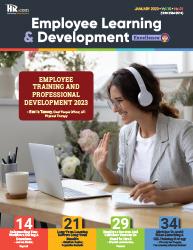

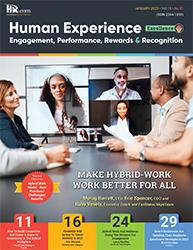

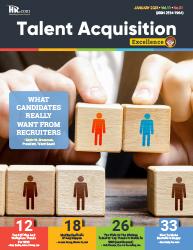



Like to submit an article? Use our online submission form or for more information go to www.hr.com/ExcellencePublications Publications 13 Targeted Publications to Reach Your Audience Informing, Educating, Enlightening and Assisting HR professionals in their personal and professional development, the Excellence series offers high-quality content through the publications!



























 Dave Ulrich
Rensis Likert Professor, Ross School of Business, University of Michigan Partner, The RBL Group
Julie Winkle Giulioni Author, Virtual /Live Keynote Presenter, Inc.’s Top 100 Leadership Speakers
Dr. Beverly Kaye CEO, BevKaye&Co.
Dave Ulrich
Rensis Likert Professor, Ross School of Business, University of Michigan Partner, The RBL Group
Julie Winkle Giulioni Author, Virtual /Live Keynote Presenter, Inc.’s Top 100 Leadership Speakers
Dr. Beverly Kaye CEO, BevKaye&Co.
















































